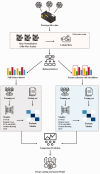Improving accuracy of vascular access quality classification in hemodialysis patients using deep learning with K highest score feature selection
- PMID: 38573764
- PMCID: PMC10996358
- DOI: 10.1177/03000605241232519
Improving accuracy of vascular access quality classification in hemodialysis patients using deep learning with K highest score feature selection
Abstract
Objective: To develop and evaluate a novel feature selection technique, using photoplethysmography (PPG) sensors, for enhancing the performance of deep learning models in classifying vascular access quality in hemodialysis patients.
Methods: This cross-sectional study involved creating a novel feature selection method based on SelectKBest principles, specifically designed to optimize deep learning models for PPG sensor data, in hemodialysis patients. The method effectiveness was assessed by comparing the performance of multiple deep learning models using the feature selection approach versus complete feature set. The model with the highest accuracy was then trained and tested using a 70:30 approach, respectively, with the full dataset and the SelectKBest dataset. Performance results were compared using Student's paired t-test.
Results: Data from 398 hemodialysis patients were included. The 1-dimensional convolutional neural network (CNN1D) displayed the highest accuracy among different models. Implementation of the SelectKBest-based feature selection technique resulted in a statistically significant improvement in the CNN1D model's performance, achieving an accuracy of 92.05% (with feature selection) versus 90.79% (with full feature set).
Conclusion: These findings suggest that the newly developed feature selection approach might aid in accurately predicting vascular access quality in hemodialysis patients. This advancement may contribute to the development of reliable diagnostic tools for identifying vascular complications, such as stenosis, potentially improving patient outcomes and their quality of life.
Keywords: 1 D convolutional neural network; Deep learning; end-stage renal disease (ESRD); hemodialysis; photoplethysmography; vascular access quality.
Conflict of interest statement
Declaration of conflicting interestsThe authors declare that there is no conflict of interest.
Figures



Similar articles
-
DeepVAQ : an adaptive deep learning for prediction of vascular access quality in hemodialysis patients.BMC Med Inform Decis Mak. 2024 Feb 12;24(1):45. doi: 10.1186/s12911-024-02441-2. BMC Med Inform Decis Mak. 2024. PMID: 38347504 Free PMC article.
-
Enhancing the prediction of IDC breast cancer staging from gene expression profiles using hybrid feature selection methods and deep learning architecture.Med Biol Eng Comput. 2023 Nov;61(11):2895-2919. doi: 10.1007/s11517-023-02892-1. Epub 2023 Aug 2. Med Biol Eng Comput. 2023. PMID: 37530887
-
Blood pressure estimation and classification using a reference signal-less photoplethysmography signal: a deep learning framework.Phys Eng Sci Med. 2023 Dec;46(4):1589-1605. doi: 10.1007/s13246-023-01322-8. Epub 2023 Sep 25. Phys Eng Sci Med. 2023. PMID: 37747644
-
Deep Learning Approaches to Detect Atrial Fibrillation Using Photoplethysmographic Signals: Algorithms Development Study.JMIR Mhealth Uhealth. 2019 Jun 6;7(6):e12770. doi: 10.2196/12770. JMIR Mhealth Uhealth. 2019. PMID: 31199302 Free PMC article.
-
COVID-19 diagnosis: A comprehensive review of pre-trained deep learning models based on feature extraction algorithm.Results Eng. 2023 Jun;18:101020. doi: 10.1016/j.rineng.2023.101020. Epub 2023 Mar 16. Results Eng. 2023. PMID: 36945336 Free PMC article. Review.
References
-
- Htay H, Bello AK, Levin A, et al.. Hemodialysis use and practice patterns: an international survey study. Am J Kidney Dis 2021; 77: 326–335 e1. - PubMed
-
- Kingsmore DB, Stevenson KS, Jackson A, et al.. Arteriovenous access graft infection: standards of reporting and implications for comparative data analysis. Ann Vasc Surg 2020; 63: 391–398. - PubMed
MeSH terms
LinkOut - more resources
Full Text Sources

